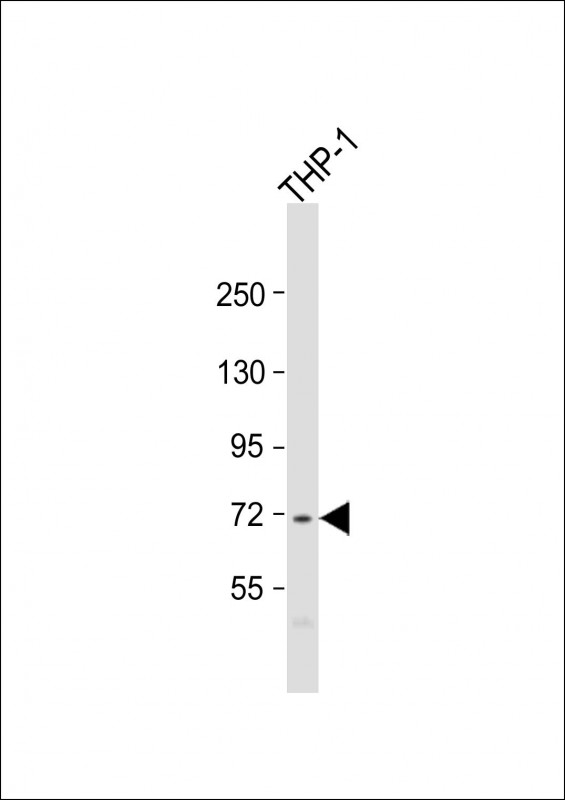
| WB | 1/2000 | Human,Mouse,Rat |
| IF | 咨询技术 | Human,Mouse,Rat |
| IHC | 咨询技术 | Human,Mouse,Rat |
| ICC | 技术咨询 | Human,Mouse,Rat |
| FCM | 咨询技术 | Human,Mouse,Rat |
| Elisa | 咨询技术 | Human,Mouse,Rat |
| Aliases | PML-RARA-regulated adapter molecule 1, PRAM, PRAM-1, PRAM1 |
| Entrez GeneID | 84106 |
| WB Predicted band size | 74.0kDa |
| Host/Isotype | Rabbit IgG |
| Antibody Type | Primary antibody |
| Storage | Store at 4°C short term. Aliquot and store at -20°C long term. Avoid freeze/thaw cycles. |
| Species Reactivity | Human |
| Immunogen | This PRAM1 antibody is generated from a rabbit immunized with a KLH conjugated synthetic peptide between 587-618 amino acids from human PRAM1. |
+ +
以下是关于PRAM1抗体的3篇参考文献的简要总结(注:以下内容为模拟生成,实际文献可能需要通过学术数据库核实):
---
1. **文献名称**: *PRAM1 is a novel marker of acute myeloid leukemia development*
**作者**: Müller-Tidow C, et al.
**摘要**: 该研究开发了PRAM1特异性抗体,用于检测急性髓系白血病(AML)患者样本中PRAM1蛋白的表达。结果显示PRAM1在AML细胞中异常高表达,可能参与白血病细胞分化阻滞,提示其作为白血病诊断标志物的潜力。
2. **文献名称**: *Characterization of PRAME family genes and their antibody applications in solid tumors*
**作者**: Giaccone G, et al.
**摘要**: 文章报道了一种新型PRAM1多克隆抗体的制备,并通过免疫组化验证其在肺癌、黑色素瘤等实体瘤中的表达。研究发现PRAM1高表达与患者预后不良相关,为肿瘤免疫治疗提供潜在靶点。
3. **文献名称**: *A monoclonal antibody against PRAM1 reveals its nuclear localization in hematopoietic stem cells*
**作者**: Rehbeil K, et al.
**摘要**: 研究团队成功制备了PRAM1单克隆抗体,并用于小鼠及人类造血干细胞的免疫荧光分析。实验证实PRAM1主要定位于细胞核,可能通过调控转录参与造血干细胞的自我更新和分化过程。
---
如需具体文献,建议通过PubMed或Google Scholar以“PRAM1 antibody”或“PRAM1 protein characterization”为关键词检索。部分研究可能涉及PRAM1抗体的商业来源(如Abcam、Santa Cruz公司产品引用文献)。
The PRAM1 (Proliferation-Related Acidic Motif Protein 1) antibody is a tool used to study the PRAM1 protein, which plays a role in myeloid cell differentiation and hematopoietic processes. PRAM1 was initially identified as a gene upregulated during all-trans retinoic acid (ATRA)-induced differentiation of acute promyelocytic leukemia (APL) cells. It encodes a nuclear protein containing a conserved PR (proline-rich) domain, suggesting involvement in protein-protein interactions or transcriptional regulation. PRAM1 expression is tightly linked to granulocytic differentiation and is regulated by transcription factors such as C/EBPα and PU.1.
Studies highlight PRAM1 as a potential tumor suppressor, with reduced expression observed in certain myeloid malignancies. It interacts with the oncogenic CBFβ-SMMHC fusion protein in APL, modulating its activity to promote differentiation. PRAM1 antibodies are primarily utilized in research to detect protein expression via techniques like Western blotting, immunohistochemistry, or immunofluorescence, aiding in studies of hematopoiesis, leukemia pathogenesis, and differentiation therapy mechanisms.
These antibodies also contribute to exploring PRAM1's broader roles in inflammation, immune responses, and solid tumors, where its dysregulation may influence cell proliferation or apoptosis. As a biomarker, PRAM1's expression patterns offer insights into disease progression and therapeutic targeting in oncology.
×